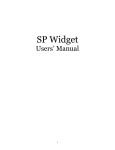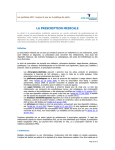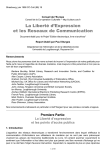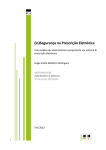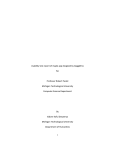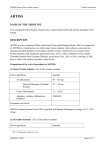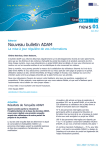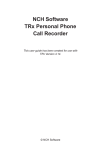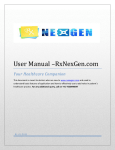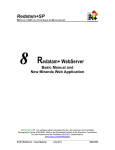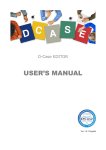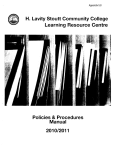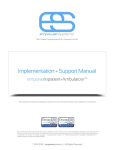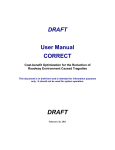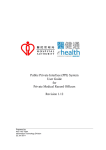Download D1.2.4_Appendix A_Simulated Consultation Healthcare
Transcript
Smart Open Services for European Patients Open eHealth initiative for a European large scale pilot of Patient Summary and electronic Prescription D1.2.4_Appendix_A_Simulated Consultation Healthcare encounter WORK PACKAGE WP 1.2 DOCUMENT NAME D1.2.4_Appendix_A_ Simulated Consultation _Health encounter SHORT NAME Simulated Consultation DOCUMENT VERSION 1.0 DATE Version 1.0 07/07/2014 1 D 1.2.4. Evaluation Results Simulated Consultation Document Short name: Appendix_A_SC_HE Version: V1.0 Date: 07/07/2014 COVER AND CONTROL PAGE OF DOCUMENT Document name D1.2.4_Appendix_A_Simulated consultation_Healthcare encounter Document Short name: Simulated Consultation_Healthcare encounter Distribution level PU Status Final version Author(s): Organization: CAHIAQ (CAHTA) Dissemination level: PU = Public, PP = Restricted to other programme participants, RE = Restricted to a group specified by the consortium, CO = Confidential, only for members of the consortium. ABSTRACT This document deals with the results of the Simulated consultation (SCs) and healthcare encounters which took place in different epSOS participating pilot countries as a pilot test for evaluating the use, end users’ acceptance and potential impact of Patient Summary (PS) and electronic prescription (eP) services. In this document, the methods, results and conclusions will be presented. Change History Version Date Status From Details Review Changes V0.1 16/06/2014 Draft CAHIAQ V0.2 30/06/2013 Final after QR CAHIAQ V1.0 07/07/2014 Final APM Version 1.0 WP1.2 version number 2 D 1.2.4. Evaluation Results Simulated Consultation Document Short name: Appendix_A_SC_HE Version: V1.0 Date: 07/07/2014 Table of Contents 1. Simulated Consultations/healthcare encounters........................................................ 4 1.1 Background .......................................................................................................... 4 1.2 Objective .............................................................................................................. 4 1.3 Methods ............................................................................................................... 4 1.4 Results ................................................................................................................. 7 1.5 1.4.1 Perception and acceptance of epSOS services according to the patient 8 1.4.2 Perception and acceptance of epSOS services according to the HPs .... 8 1.4.3 Health professional interviews ............................................................... 9 Conclusions........................................................................................................ 20 Annex 1 - epSOS - Experiences from eP-pilot in Haparanda, Sweden .......................... 21 Annex 2 - Categories, subcategories and some examples of health professionals’ comments. ......................................................................................................................... 23 Version 1.0 3 D 1.2.4. Evaluation Results Simulated Consultation Document Short name: Appendix_A_SC_HE Version: V1.0 Date: 07/07/2014 1. Simulated Consultations/healthcare encounters 1.1 Background The evaluation work package adjusted its activities and plan (Deliverable 1.2.2 and Deliverable 1.2.1: EED_Evaluation pilot plan_epSOS phase I on the basis of introducing virtual hypothesis scenarios through Simulated Consultations (SC) performed by volunteer patients offering their real Patient Summary (PS) and consulting the Health Professionals (HP) in a Point of Care (PoC) or pharmacy for a check up, health advice or clinical doubt with no real need for healthcare. This scenario implied also a qualitative approach through indepth interviews covering aspects about the opinion, perception, and potential impact of epSOS services. Additionally, aspects addressing barriers and facilitators of epSOS are also addressed. This document looks at the objectives, methods, results and conclusions of the SCs and Health encounters performed from November 2012 to June 2014. 1.2 Objective To know and study the perception, acceptance and potential impact of epSOS services according to the opinion of end-users (health professionals and patients) after the health encounter. 1.3 Methods Quantitative and qualitative approaches were used for simulated consultations (SC) and health encounters. Patients, HPs: physicians for PS and pharmacists for Electronic Prescription (eP) services participated in the health encounters. Each HP could participate in one or more SCs. During the consultation, patients were identified, gave informed consent, and their patient summary or electronic prescription was retrieved. Quantitative approach: After the consultation, the HP filled in an online questionnaire on legal issues (informed consent) and on different aspects of the service (legal aspects, availability and service usability of the service). A paper based questionnaire on legal and service aspects of the Version 1.0 4 D 1.2.4. Evaluation Results Simulated Consultation Document Short name: Appendix_A_SC_HE Version: V1.0 Date: 07/07/2014 service was administered to the patients. The patient questionnaire consisted of 5 closed questions with a Likert scale and one open question. Qualitative approach Semi-structured interviews were carried out with physicians and pharmacists who had participated in some of the consultations in order to gain an insight into their opinion of the service. In the interview, information was requested on service aspects (availability, usability, semantics, legal issues and security), potential impact, barriers and facilitators (Box 1). The interviews were conducted in English with the exception of Spain where the interview was performed in the native language of the interviewer and interviewee. Thereafter, the content was translated into English. The interviewers requested permission to record the conversation and guaranteed confidentiality. The interview was encoded with one identifier, and was transcribed. The in-depth interview was not always performed in all the consultations. . Version 1.0 5 D 1.2.4. Evaluation Results Simulated Consultation Document Short name: Appendix_A_SC_HE Version: V1.0 Date: 07/07/2014 Box 1. Guideline for Health professional interviews Experience of the epSOS Service ¬ Description of the event, see the process and difficulties Opinion in the service aspects: availability, usability, semantics, legal issues and Privacy-confidentiality ¬ aspects to improve Opinion about the service: ¬ advantages ¬ potential impacts of use ¬ barriers and facilitators ¬ compatibility with daily practice Data analysis ¬ attitude towards and acceptance of the epSOS A descriptive analysis for the questionnaires was carried out with frequency distribution. For service the interviews, content analysis was conducted to refine subthemes, make comparisons between cases, and identify contradictions and outliers. Findings were triangulated, reaching coding consensus with the research team and emerging themes discussed. The results of transcription were contrasted by informants. Version 1.0 6 D 1.2.4. Evaluation Results Simulated Consultation 1.4 Document Short name: Appendix_A_SC_HE Version: V1.0 Date: 07/07/2014 Results The following sections describe the results of the questionnaires (patient and HP) and the HP interviews. Table 1 shows the total number of simulated consultations and health encounters performed. Table1. Total number of simulated consultations and health encounters performed (from November 2012 to June 2014) Service Country B Patients (N) Country A (from patients) SC Spain (Mallorca) 4 France, Italy, Switzerland and Turkey X Spain (Valencia) 1 France Portugal(Lisbon) 4 France, Italy, Malta and Switzerland. France (Paris, Nanterre University) 1 Spain Italy ( Desenzano ) 2 Estonia Portugal (Porto) 1 Italy Denmark (Copenhagen) 4 Sweden and Italy. X Spain (Seville) 4 Finland, Italy and Sweden X Denmark (Copenhagen) 1 Sweden Sweden 17 Finland Sweden 2 Croatia Greece (Athens) 2 Sweden PS eP Simulated consultations* 15 Health encounters 28 Total 43 Version 1.0 X 7 D 1.2.4. Evaluation Results Simulated Consultation Document Short name: Appendix_A_SC_HE Version: V1.0 Date: 07/07/2014 A total of 43 patients participated in the simulated consultations and health encounters, and 31 patient questionnaires were obtained. Six health professionals (physicians and pharmacists) participated in the in-depth interview and a total of 32 HP questionnaires were filled in after the health encounter. 1.4.1 Perception and acceptance of epSOS services according to the patient (N=31) After the encounters, patients answered the questionnaire about the epSOS service (n=31). All patients gave their informed consent and considered legal aspects carefully. Data privacy was appropriately maintained. Regarding service dimensions, all patients evaluated each aspect. Most of the respondents (N=24) reported that the PS and the eP services were useful for exchanging medical information and a good communication tool (N=26). (Figure 1) 1.4.2 Perception and acceptance of epSOS services according to the HPs After the visit, the HP online questionnaire was filled in but in some cases it was not possible because of technical problems. Therefore 32 questionnaires were completed. Regarding the service, HPs’ answers showed "‘strongly agreed’ and “agree” in most of the questions, Version 1.0 8 D 1.2.4. Evaluation Results Simulated Consultation Document Short name: Appendix_A_SC_HE Version: V1.0 Date: 07/07/2014 especially in the ease to use, the understanding of data and the sense of titles and subheadings for the data. (Figure 2) 1.4.3 Health professional interviews A total of 6 HPs participated in the semi-structured interviews, 4 physicians and 2 pharmacists. The most outstanding aspect that HPs reported after using the service was the utility of the service. It was also felt that it is a service for the future that reduces language barriers and it’s an improvement but which needs to be gradually improved. The results were grouped according to following dimensions: availability, service and social aspects, potential impact, barriers and facilitators, according to the viewpoint of Health professionals (Physicians or Pharmacist). The quotes are written in italics between square brackets and with the code of the informant. Figure 3 shows dimensions, categories and subcategories. Figure 3: Dimensions, categories and subcategories of the main areas: availability, service and social aspects, potential impact, barriers and facilitators Version 1.0 9 D 1.2.4. Evaluation Results Simulated Consultation Document Short name: Appendix_A_SC_HE Version: V1.0 Date: 07/07/2014 SERVICE ASPECTS Acess to system Usability Semantics Format aspectes (structured information, rigidity system) Ease of use IT Architecture Understan ding Adequate information SOCIAL ASPECTS Legal issues Ethic Issues Data security Professional ethics Security Missing information POTENTIAL IMPACT Contextual aspects Communication Clinical Safety Reducing language barriers Patient's clinical safety Access to system Accessibility, IT Architecture, System rigidity Different health system card Personal aspects Health professional computer skills Impact on service Confidence Patient's emotional safety Data reiability BARRIERS Technology Technological Impact on time FACILITATORS Contextual aspects Low use Time and burden of work Legal aspects Different laws , drugs... Ease of use Easy to access, User manuals Technology Safety Integrated systems Patient's clinical safety There have been two cases where simulated patients could not access the epSOS service. One for technical reasons and another because the patient did not present the appropriate id card number at the moment of the visit. This last issue was highlighted as a weakness for the availability of the service. a) Service aspects The opinions of the professionals are described according to the following subcategories: response time, usability, semantics, as well as technological security issues The HPs reported that the service was accessible with an adequate response time, but they also mentioned that it could be improved with more speed. They valued the usability of the service positively, considering it easy to use. In relation with the format, one of the participants said that the information was well structured and classified, while others considered that the format could be better. Version 1.0 10 D 1.2.4. Evaluation Results Simulated Consultation Document Short name: Appendix_A_SC_HE Version: V1.0 Date: 07/07/2014 [‘…I think that it would be much more operational to have a visual with single-screen view, not to have so much information up front but instead have summarised information on the prescriptions that a patient has active at that moment in time, and for each of them to offer more detail … that would make it much faster because by refreshing the screen once, we could do the dispensing … It gives you an idea of the patient’s global treatment, that first of all, but then it could almost be managed by blocks, on a dialogue basis’ (EP2)] Another aspect considered mainly by the physicians is the rigidity in the use of the system. For example in the limitations of some sections, mandatory fields not required in the epSOS minimum data set or the fact that it is not possible to add new fields [‘I have also experienced certain difficulties, particularly with respect to vaccines ... and allergies too … because I believe you need to indicate the start and end dates. It’s difficult to insert an end date, and then the patient not necessarily remember the date of the allergy It’s an important detail that ought to be included. It’s essential that all allergic reactions are recorded in a file: the Patient Summary. Sometimes you have to more or less invent the date if you want to include the day and month. Otherwise there’s no way you can do it, the system’s so rigid.’ (HP4)] Additional usability aspect mentioned, especially for pharmacists, is in relation to IT architecture, and some of examples given by respondents suggested the fact of integrating patient consent electronically in the epSOS system or integrating epSOS service in each local health information system. [(...) But at the same time as I operate the epSOS system, I operate my own pharmacy system (...) Completely independent, and that would be something for the future, to merge those two systems (...) Well, the advantages would be you wouldn’t have to flick between screens. As it is now, you have to flick between the screens in order to get the information and I translate. I take the information from the EPSOS system and I have to manually translate that into my system. I have to manually type it in... (EP1)] [I believe that in the future yes, we should achieve integration of the management programs... that would be ideal, a file exchange system that pharmacy management programs can interpret, capturing the information, which would make it much more flexible’ (EP2)] Finally, technological security aspects of the service were positively valued. However, one pharmacists suggested to improve the control to dispense system by double check of the Version 1.0 11 D 1.2.4. Evaluation Results Simulated Consultation Document Short name: Appendix_A_SC_HE Version: V1.0 Date: 07/07/2014 dispensation (confirm by a scanning that the medicines dispensed to the patient are the same as ones introduced in the patient history). [‘‘Here in Andalusia we have a checking system that we find works very well, where we can confirm through scanning that what I am saying digitally that I am going to give the patient coincides with what I physically give to the patient, to avoid any errors, errors in interpretation…. That would be a suggestion that I would add for extra safety.’ (EP2) ‘] As for semantic aspects, HPs reported that the information was presented in a comprehensible manner, without half-translated texts or inconsistencies. The adequacy of information on the PS was evaluated by one of the physicians as correct and insufficient in some aspects by the other, for example non specific diagnosis or more complete information about other aspects was needed. [‘the active principle is correctly translated’ (HP1)] [‘... there had been a surgical procedure but it did not specify which’ (HP2)] On the other hand, missing information was identified by other participants, for example the doctors’ comments had not been translated, a section which may help the HP in the clinical decision making process, some information about diagnosis, surgery or detailed allergies was missing. [‘I would add that there was a student who was allergic to a specific kind of food but who was not on the list. I don’t remember what happened, but I couldn’t find it on the list.’ (HP4)] [‘As far as surgical case history is concerned, one student had had an operation on an abscess or something like that, but I couldn’t find any record of his operation and there was no listing. His operation was not listed so it couldn’t be found...there is no list to choose from.’ (HP4)] An other suggested improvement is to have more detailed data on prescriptions as the name of medicine or dosage, in the case of the pharmaceutical.. In this sense, one of the pharmacists suggested to include a patient’s prescription history as an element of support for decision making. [(…)'What would be really nice – and that’s just drawing on my experience from our general system – is that if you there could have a lot of data perhaps, when it was prescribed, more data before you Version 1.0 12 D 1.2.4. Evaluation Results Simulated Consultation Document Short name: Appendix_A_SC_HE Version: V1.0 Date: 07/07/2014 select it, more data; what the name of the medicine is, what the active ingredient is, what the strength of it is.' '(...) I need to pick to ensure patient safety (…) (EP1)] [‘Something that I think is very important that is missing in this area... is that the dose be indicated…. I think that it’s a very important detail, first for checking that the patient is well informed and is taking the medication appropriately, that he/she has that information. It is important first for patient safety and second to check treatment adherence’ (EP2)] b) Social aspects Legal aspects (process of data identification and informed consent) were positively valued. One of the interviewed discussed the importance of ethical aspects for confidentiality of data by the doctor and other emphasized the importance of rigorous process, the need of digital access and within the site. He also suggested translating the consent in both languages. [‘…on the subject of data protection… it should all be as rigorous as possible…, access to the system, if possible, here we demand that it cannot be digitally keyed in, but should include a card reader because that guarantees… or rather, to put it another way, with regard to the data protection law, confidentiality would not be guaranteed.’ (EP2)] c) Potential impact In general the comments in this section highlight the utility of the tool. The main two potential impacts identified were about communication and clinical safety of the patient. The service is well appreciated in reducing language barriers, having the information available without relying on the patient´s language. [‘I am delighted. This is a step forward for me as I am now old, I think it’s an incredible step forward and I am happy. ’(HP3, ‘It’s an improvement compared with the paper prescription from Italy, for instance. That would be an improvement’ (EP1)] ['... for us to have a clinical report in a language that one can understand is really good and useful' (HP1)] [‘It is a tool with great future … In places like Mallorca or tourist sites where there is a large foreign population it is very useful to have the patient´s medical history in their own language and not be dependent on insufficient language skills. It is a tool that is now in the initial phase and that can be greatly improved upon...’ (HP2)] Version 1.0 13 D 1.2.4. Evaluation Results Simulated Consultation Document Short name: Appendix_A_SC_HE Version: V1.0 Date: 07/07/2014 The other potential impact, clinical safety of the patient, is related with the assistance to clinical decision making. ['It seems very interesting to me because it means having access to a patient’s history who is away from home and in this way, we have a lot of data of their clinical history which we can use. As in this case, where she was allergic to penicillin because if she had needed it, it would have suited me very well. (HP3)] ‘…As a professional it gives me the security that this patient has this treatment prescribed... and also you give me a name and that name is linked to a prescription and furthermore I have a confirmation, which gives me that security. (EP2)] However, it’s important to keep in mind the lack of some relevant information to security. Finally, another potential impact stated was that the epSOS service involves saving time compared to the traditional system. [ (...) The problem is again as we talked about; there’s no indication and there’s no dosage. So the patient has to know exactly how to take the medicine and not all patients know that. Which is for us a concern about patient safety (...) (EP1)?] Other issues covered by the HPs were the utility of the tool to obtain confidence in relation to reliable data (for instance, data that is not dependent on the patient's memory or when it’s not the patient who collects the medicine in a pharmacy). In addition, the tool can provide confidence in relation to the patient’s emotional safety. [‘‘…I have perceived the information I got as very secure (...) I think that the technological part complies with security measures both in our country as well as in other epSOS countries’ (HP1)‘] d) Barriers and facilitators The main barrier reported by professionals was on technological aspects related to usability. The fact to move between many screens, the rigidity of the system in some cases or, as happened in one case, when the access to the service failed. It should be noted as an important barrier for the availability the different health system cards in each country included in the service. This was the reason why one patient was unable to access the system so his card was not included in the service. [‘the tool runs faster or slower depending on the band width...’ (HP1)]; Version 1.0 14 D 1.2.4. Evaluation Results Simulated Consultation Document Short name: Appendix_A_SC_HE Version: V1.0 Date: 07/07/2014 [‘‘The structure is already very rigid, too rigid.’ (HP4)‘] [‘The first time the patient came, it we didn’t succeed to enter because we didn’t know what number to choose to identify him. We had trouble locating the identifiers on the cards ... it’s very complicated.’ (HP4)] The following aspects were stated by different professionals: a) Legal aspects, because there are different drug legislations in each country. [‘I think differences in legislation. We are bound by legislation, so that if you were prescribed Simvastatin which has 10 tablets in it, we don’t have that on the market, and we cannot give you a package with 30 tablets in it, because that would exceed the amount of tablets which were allowed. It’s very marginal, or very little in that window. That would be a frustration also for customers coming in; “Well, I’m an epSOS patient. My Italian physician has prescribed this medicine, Simvastatin 20mg, 10 tablets,” and we’d say, “Well, I have large Simvastatin, 20mg, but I don’t have any of 10 tablets. I cannot help you.” Then we’re just back to the old system just out of frustration for the epSOS system. (...) ' Exactly. Just as there may be medicines in other countries, there may be medicines in Italy which are not on the market in Denmark...' (EP1)]; b) Personal aspects, as the HPs’ computer skills, that is, the ability to use the tool, even though the tool is considered easy to use. [‘‘Barrier on the part of the health professional for lacking computer skills, that is, if a professional uses a computer tool like us, somehow he will not have that problem. For some people computer skills are hard to acquire and will also run into difficulties, but that won´t be an added problem’ (HP2)’] c) Contextual aspects, such as time and burden of work, an aspect which might make the service difficult to use or the low use of the system, because the use can make it more easy to use. Moreover, some facilitators’ were identified, for instance the ease of using the tool or the user manuals. One aspect highlight was the integrated systems. It was also discussed the safety as a facilitator to use the system. Finally, it would need more information to patients and professionals about the appropriate cards to access the system. [‘The best way would be to integrate it in the pharmacy system. That would be absolutely the best way to do it. So if it was possible for the epSOS or the national health IT IN Denmark to collaborate Version 1.0 15 D 1.2.4. Evaluation Results Simulated Consultation Document Short name: Appendix_A_SC_HE Version: V1.0 Date: 07/07/2014 with those companies who make up our pharmacy system, and their exchange codes, and update our pharmacy system where it’s integrated, that would absolutely be the best way’ (EP1)] [‘the integration with the management program makes our work much easier as we don’t have to go to the black box to see if I have it or not and so on... we could include, just as other programs include, being able to substitute it with what I do have …’ (EP2)]. [‘And then facilitators, which we have talked about, above all it is security, I think that it is the security that it gives me, I even think that I feel greater security myself than the patient does.’ (EP2)] e) Other aspects The professionals agreed that it was feasible to implement epSOS services, taking into account the tourist context, or depending on the specific patients They also reported that the tool was compatible with daily practice, as little time is needed and can even reduce the consultation time with foreign patients. But, one participant pointed out that this was also difficult because of the burden of work in daily practice. Finally, the training received was also positively assessed. ['the tool is feasible for some patients, for instance those that have more complex pathologies, those who cannot communicate well with the physician and discuss their diseases, those with comorbidities, or chronic patients with many drugs prescribed’ (HP2)] Table 2 shows the different opinion of physicians and pharmacists about the epSOS service. Version 1.0 16 Table 2. Dimensions, categories and subcategories according type of opinion (favourable, aspects to improve or facilitators, and weaknesses or barriers) and professionals (physicians and pharmaceuticals) Dimensions Categories Weaknesses or Barriers Strengths or Facilitators Aspects to improve Availability Access to system The service depends of the bandwidth (failed service) Different health system card in each country Information to users about the appropriate cards for service access Adequate response time Improve time response (speed) Service aspect Response time Usability Semantics Easy to use HPs’ computer skills Format: (Structured information) Well-structured and classified Format (Rigidity system) Limitations of some sections Mandatory fields not required (i.e. date) Not possible to add new fields IT Architecture Need to move between different screens Understanding Easy to use Help functions (built-in functions in the system) User manuals Better format Portal: First screen with a summary prescriptions with details for eP system Integrated systems (epSOS in the local system) Information presented in a comprehensive manner, without half translated texts or inconsistencies Adequacy of information Version 1.0 17 D 1.2.4. Evaluation Results Simulated Consultation Dimensions Categories Missing information Security Document Short name: Appendix_A_SC_HE Version: V1.0 Date: 07/07/2014 Weaknesses or Barriers Strengths or Facilitators Not specific diagnoses or more complex information (eg. blood pressure) Physician’s comments or specific clinical information (eg. specific surgery, etc.) Aspects to improve Translate comments’ doctor field More detailed data on prescriptions as the name of medicine or dosage Include specific diagnosis and surgeries Include dosage Patient’s prescription history as an element of support for decision making System of control to dispense the medicines (confirm by a scanning that the medicine dispensed to the patient are the same ones as introduced in the patient history) Technological Social aspect Legal aspects Data security, ethics legislations) Different drug legislations in each country More rigorous process: digital access and within the site Translation of the consent In both languages Time and burden or work, Low use of the system Contextual aspects Potential impact Communication Reducing language barriers Safety Patient’s clinical safety Confidence Data reliability Version 1.0 Allows to reduce language barriers Provides information without relying on the patient’s language Missing of some relevant information to security like dosage Allows accessing to relevant information that is helpful for clinical decision making Ensures confidence in relation to reliable data (not dependent on the patient’s memory) 18 D 1.2.4. Evaluation Results Simulated Consultation Dimensions Impact on service Version 1.0 Categories Weaknesses or Barriers Document Short name: Appendix_A_SC_HE Version: V1.0 Date: 07/07/2014 Strengths or Facilitators Patient’s emotional safety Provides confidence to the patient Saving time Reduces consultation time with foreign patients 19 Aspects to improve 1.5 Conclusions In general, HPs as well as patients participating in the health encounters reported a positive opinion about the epSOS service after using it. The utility in the exchange of medical information and communication was pointed out in both services (PS and eP). The opinions of interviewers about the service were analysed according the following dimensions: availability, service and social aspects, potential impact, barriers and facilitators. The interviews showed some relevant aspects to be considered: HPs showed a favourable opinion on the formal aspects of the service (understandable information, accessible time, ease of use, etc.), However, they also reported that some of these aspects could be improved. HPs felt that it was feasible to implement the service and compatible with every day clinical practice. Regarding the potential impact on clinical and pharmaceutical practice there was a favourable view of the epSOS service as a communication tool (useful in reducing language barriers), confidence (data reliability, patient emotional safety) and impact on saving time. In relation to security of the tool, as mentioned above, it would be necessary more complete clinical and pharmaceutical information. As barriers, technological aspects, personal skills (ability to handle computer applications) and context variables (different drug legislations among countries) were identified, among others. Moreover, the ease of use, user manuals or integrated systems were some of the facilitators stated. These results provide the first opinions on the tool after the use of epSOS services. In addition, some barriers, facilitators and areas of improvement have been identified. However, a large number of SCs is needed to reach data saturation and the representativeness of the sample. Version 1.0 20 D 1.2.4. Evaluation Results Simulated Consultation Document Short name: Appendix_A_SC_HE Version: V1.0 Date: 07/07/2014 Annex 1 - epSOS - Experiences from eP-pilot in Haparanda, Sweden Background The representatives of the ePrescription pilot sites in Sweden could not attend the focus group of ePrescription service that was held in Barcelona. For this reason, a phone interview was performed to both pharmacies on the 14th May. This report includes the content of both interviews and the results will be integrated in the final D 1.2.4 Interview content description Two pharmacists working in a pharmacy in the north of Sweden were interviewed by telephone during one hour 2014-05-14. They have worked as pharmacists for 20 and 5 years respectively. The pharmacy acting as a pilot in epSOS is situated very close to the Finnish border so besides the Swedish customers they have mostly Finnish customers. Both pharmacists felt that the information and education prior to the pilot, about the epSOS service ePrescription (eP), was easy and adequate but that the time between this and the start of the pilot, i.e. a couple of months, was too long. Use of epSOS Both pharmacists felt excited to participate in the pilot and to test the eP-service though this service already had a demand by their Finnish customers. The pharmacists think that the ePservice is easy to use and they had no problems to start using it in their daily work. Before the pilot started they had a doubt about the status of the eP-service but after a short time using the eP-service one of the pharmacists said that the service felt like it was “for real”. The pharmacists compared the eP-service with paper prescriptions. They get the same information and think the services are comparable but that it is easier and quicker to process the service for the customer with the paper prescription due to the language barriers. With paper prescriptions they don’t have to inform the customer about the need of for example the consent, identification number etc. as they have to do with the eP-service. They have a brochure in Finnish for the Finnish customers but this “extra” is also time-consuming even if it is good. The pharmacists have been able to dispense medicines to seven “real” customers during the pilot. This can be compared to nearly 30 customers that they had to refuse because of no consent in advance. The pharmacists do not know why some customers know and some do Version 1.0 21 D 1.2.4. Evaluation Results Simulated Consultation Document Short name: Appendix_A_SC_HE Version: V1.0 Date: 07/07/2014 not know about the need of consent. Both the pharmacists are confident in the identification of the customers though they are used to look at Finnish identifications. The eP-service has been down during approximately two weeks during the pilot. This time and when the pharmacists can’t serve the Finnish customers due to lack of consent, they refer the clients to a Finnish pharmacy nearby. Improvements The pharmacists propose that the eP-service has to be more integrated in their regular system. Today they have to leave the counter and the customers to handle the eP-service in another room, print out the prescription and register it in the regular system. Improvement of the eP-service is also to allow the possibility to regret. Today the pharmacists can’t regret if they press wrong amount, wrong dose etc. Instead they have to start again. The surveys, for the patient and the pharmacists, have been very time-consuming and the pharmacists questioned the objectivity of the customers when the pharmacists ask customers to answer the survey and the customer has to return it answered to the pharmacist. Version 1.0 22 Annex 2 - Categories, subcategories and some examples of health professionals’ comments. Core Subcategories Codes categories Quotes Service aspects ‘I think it is quite accessible. We conducted a consultation in 4 minutes, just under 5 minutes, which is quite accessible. I have also shown the patient the summary in his own language, which I could have spared of course, but did just so, so that the patient could see that all sections had been completed, right? But on many occasions this is not necessary and therefore I think that the time spent is quite reasonable’ (HP1) Response time ‘Relatively well considering it was a rather exceptional dispensation …A dispensation with a foreign patient where there is a language barrier, I think it might even be a step forward. I imagine myself in that same situation with a piece of paper in Swedish, and things would be rather complicated, would they not?’ (EP2) ‘The speed of it is not the fastest. It does take some time, and I think it’s just because so much data has to go back and forth and you have to find it (...) But that speed could be improved’ (EP1) Usability Ease to use ‘It is very intuitive, no problem (...) Any user can learn how to use it, it is very easy to learn how to use the tool’ (HP2) ‘It is relatively easy... this is a system that is much more simple (than autonomous systems), more primary, more basic and it is very helpful compared with what we have’ (EP2) It’s quite user friendly. As I said, if there could be some more built-in functions in the system, if the codes in the lock in process… if it was written where I could find those and if there was a little tag saying, “For this citizen, you need this type of documentation,” and so forth, just making it as user friendly as possible. That would be very nice. (EP1) Version 1.0 23 D 1.2.4. Evaluation Results Simulated Consultation Format aspect: structured information Document Short name: Appendix_A_SC_HE Version: V1.0 Date: 07/07/2014 ‘The information is well structured and classified’ (HP1) ‘…I think that it would be much more operational to have a visual with single-screen view, not to have so much information up front but instead have summarised information on the prescriptions that a patient has active at that moment in time, and for each of them to offer more detail … that would make it much faster because by refreshing the screen once, we could do the dispensing … It gives you an idea of the patient’s global treatment, that first of all, but then it could almost be managed by blocks, on a dialogue basis’ (EP2) The French were easier to understand, I think they are better (…) the framework (…) The French format is better than the Spanish one, it’s clearer, you understand it immediately. (HP3) Format aspect : Rigidity ‘Contraception: there’s a heading called Pregnancy in Process, which is very specific. In fact, contraceptives had to be included within Treatments, I think, and that’s not natural.’ (HP4) System ‘A student was allergic to a certain type of food, I don’t remember what kind, but I couldn’t find him in the listing, so nothing could be done on the spot because it was mandatory. I don’t remember what happened, but I couldn’t find him.’ (HP4) ‘I have also experienced certain difficulties, particularly with respect to vaccines ... and allergies too … because I believe you need to indicate the start and end dates. It’s difficult to insert an end date, and then the patient not necessarily remember the date of the allergy It’s an important detail that ought to be included. It’s essential that all allergic reactions are recorded in a file: the Patient Summary. Sometimes you have to more or less invent the date if you want to include the day and month. Otherwise there’s no way you can do it, the system’s so rigid.’ (HP4) IT architecture (electronic integration) Version 1.0 ...it would be lovely if there was just a PDF form I could click on to get the consent out, which is printed and then given to the patients so it’s in their language. The paperwork… I would need to do a written 24 D 1.2.4. Evaluation Results Simulated Consultation Document Short name: Appendix_A_SC_HE Version: V1.0 Date: 07/07/2014 consent, that would be very nice if that was accessible in that picture' (...) even if you could give the consent form electronically as well, that would be perfect' '(...) that the consent form wouldn’t be in this pharmacy, it would just be in the epSOS system, and you could pull out the data in your system .’ (EP1) (...) But at the same time as I operate the epSOS system, I operate my own pharmacy system (...) Completely independent, and that would be something for the future, to merge those two systems (...) Well, the advantages would be you wouldn’t have to flick between screens. As it is now, you have to flick between the screens in order to get the information and I then translate it. I take the information from the epSOS system and I have to manually translate that into my system. I have to manually type it in... (EP1) ‘I believe that in the future yes, we should achieve integration of the management programs... that would be ideal, a file exchange system that pharmacy management programs can interpret, capturing the information, which would make it much more flexible.’ (EP2) Semantics Understanding ‘There are no inconsistencies and there are no half translations, that is, half of the text in one language and the other half in another. Everything is displayed in Spanish or in the language of the country of origin...‘ (HP1) ‘While all items and headings were in French, the pathologies were written in Spanish except for a clinical history of allergy, which had been translated into French.’ (HP4) Adequacy of information ‘Some diagnoses are very generic; the document that opens up in the patient´s language contains more specific diagnoses; not all but some were very general. You had to specify what type of disorder, not all evidently, but some‘ (HP2) ‘And with respect to the blood pressure requirement, I feel this is a parameter that’s not a stable factor: you can have low blood pressure one day and average pressure another day. When there is previous history of high blood pressure, a patient’s pressure needs to be recorded but not on a Version 1.0 25 D 1.2.4. Evaluation Results Simulated Consultation Document Short name: Appendix_A_SC_HE Version: V1.0 Date: 07/07/2014 specific day, even though there is no mention of his/her weight or height.’ (HP4) 'Well, there was this picture where you say what type of medicine they have received. With the Missing information (about data prescription, Swedish patient, I could see what medicines, but with the Italian, there was some coding scripts, so I couldn’t really see which lines were what ' (...) 'What would be really nice – and that’s just drawing on comments…) my experience from our general system – is that if there could be a lot of data perhaps, when it was prescribed, more data before you select it, more data; what the name of the medicine is, what the active ingredient is, what the strength of it is.' '(...) I need to pick to ensure patient safety. I don’t know either how long the prescriptions are in the epSOS system; in the Danish system it’s two years max, for emergency medicine it’s seven days and then it’s gone (...)' (EP1) ‘Something that I think is very important that is missing in this area... is that the dose be indicated…. I think that it’s a very important detail, first for checking that the patient is well informed and is taking the medication appropriately, that he/she has that information. It is important first for patient safety and second to check treatment adherence.’ (EP2) ‘ … it is very handy for us to have what is called the patient’s prescription history, what we call the patient’s pharmacotherapeutic history. In the sense that, if we have any doubts, ‘I have taken, I want to take, I need and so on’, and we see any inconsistency, accessing their pharmacotherapeutic history can be very enlightening for us’ (EP2) ‘I would add that there was a student who was allergic to some kind of food and I couldn’t find it the list. I don’t remember what happened, but I couldn’t find it on the list.’ (HP4) With regard to surgical case history, a student had had an operation on an abscess or something like that, but I couldn’t find in the relevant listing. His operation was not listed and couldn’t be found ... there is no list to choose from.’ (HP4) ‘…Indicate weight and height...No weight and no height fields. Impossible to indicate waist Version 1.0 26 D 1.2.4. Evaluation Results Simulated Consultation Document Short name: Appendix_A_SC_HE Version: V1.0 Date: 07/07/2014 measurements: these are important parameters for obese patients.’ (HP4) ‘The only part that is not translated is the doctor´s comments and I don´t see why they were not. Maybe, if this part of the translation could be done - even it was with one of these translation enginesit would be good.... So again the only thing that is not translated are the doctor´s comments and sometimes these comments may contain information that may be relevant for the clinician...’ (HP1) ‘All the comments, the free comments, are not translated, but the doctor who uses the system doesn’t know that the comments will not be translated’ (HP4) Security Technological ‘…I have perceived the information I got as very secure (...) I think that the technological part complies with security measures both in our country as well as in other epSOS countries’ (HP1) ‘Here in Andalusia we have a checking system that we find works very well, where we can confirm through scanning that what I am saying digitally that I am going to give the patient coincides with what I physically give to the patient, to avoid any errors, errors in interpretation….That would be a suggestion that I would add for extra safety.’ (EP2) Version 1.0 27 D 1.2.4. Evaluation Results Simulated Consultation Core categories Document Short name: Appendix_A_SC_HE Version: V1.0 Date: 07/07/2014 Subcategories Codes Quotes Legal issues ‘I think so, because you need a number to be able to gain access or you need two numbers depending on the country, and you need to fill out the informed consent also depending on the country. ... I consider the information that I have received as very reliable. Of course there might be an exception at the time of an emergency when you are unable to receive this documentation. There is always a record of who and how the service was accessed and therefore it is important to have it under control’ (HP1) Social aspects Data security (identification process and IC) ‘The consent should appear in both languages…I had some difficulty with the interpretation…’ (EP2) ‘I believe that the consent should be in the web sphere and that there should be some kind of signature by the patient, but that would be saved... that the patient could use some kind of own personal identification code... so that the patient has to be aware he/she is giving consent, even if just a short text: ‘I consent, I authorise this person to access my data on this occasion’, something like that for the purpose of proceeding with the dispensing’ (EP2) ‘…on the subject of data protection… it should all be as rigorous as possible…, access to the system, if possible, here we demand that it cannot be digitally keyed in, but should include a card reader because that guarantees… or rather, to put it another way, with regard to the data protection law, confidentiality would not be guaranteed.’ (EP2) Professional ethics Version 1.0 ‘But the most important is for the health professional to be aware of what he or she is doing, which is very confidential indeed’ (HP1) 28 D 1.2.4. Evaluation Results Simulated Consultation Document Short name: Appendix_A_SC_HE Version: V1.0 Date: 07/07/2014 Potential impact Communication ‘...to have a clinical report in a language that can be understood is really a good thing, very useful Reducing language barriers indeed’ (HP1) ‘That is right, because now we have a certain communication problem with the patient, difficulty to understand the language of each country...’ (HP2) ‘…Here, with this, overcoming this linguistic barrier is facilitated, it is eliminated to a large extent and because afterwards we are handling the screen, then even at a certain moment when you do not share mastery of a common language, you can facilitate the patient’s comprehension of what you are dispensing to him/her, can’t you?’ (EP2) ‘And when patients are foreigners, at least for us, there is inevitably a language barrier with respect to certain health problems could be translated. That would be an asset.’ (HP4) Clinical Safety ‘For the health professional it is of great help as it helps him or her do the work, in the sense that it saves time and facilitates clinical work‘ (HP2) ‘It seems very interesting to me because it means having access to a patient’s history who is away from home and in this way, we have a lot of data of their clinical history which we can use. As in this case, where she was allergic to penicillin because if she had needed it, it would have suited me very well. (HP3) (...) The problem is again as we talked about; there’s no indication and there’s no dosage. So the patient has to know exactly how to take the medicine and not all patients know that. Which is for us a concern about patient safety (...) (EP1) Version 1.0 29 D 1.2.4. Evaluation Results Simulated Consultation Document Short name: Appendix_A_SC_HE Version: V1.0 Date: 07/07/2014 ‘…As a professional it gives me the security that this patient has this treatment prescribed... and also you give me a name and that name is linked to a prescription and furthermore I have a confirmation, which gives me that security. In other words, it gives me the security that I am attending the patient correctly, attending to a prescription that is current … No, for the system that is authorised, it is current, and therefore the physician has the capacity to control its duration’ (EP2) Confidence Data reliability ‘Then we have the medical histories of patients which contain objective data. Relying on patients may lead to confusion, as sometimes they may or may not remember, or they may say one thing when in fact it might be something else. The medical history contains validated data and is therefore highly reliable’ (HP2) Sometimes we do experience this with Danish customers as well, that is, when it’s not the patient that picks up the medicine; it’s their brother or sister, their father, their mother or whoever, who doesn’t know how they take it. But it’s just a feeling about professional confidence in what we do’ (EP1) ‘…there is a kind of contrast between what it says here and what I am really seeing.’ (EP2) Patient´s emotional safety ‘If I am a patient and I go to a foreign country , to a country that I don´t know, where they don´t understand me, and I am told not to worry that the person I am talking to knows what´s wrong with me... that gives me peace of mind,,,, this person already has information about me and knows how to help me’ (HP2) ‘For the patient there is also (security) because first we are entering their data, but in addition they are authorising us to enter their data’ (EP2) Saving time (impact on duration of care) ‘(...) So I’d say when this starts to be routine, when it’s just the epSOS system, I think it’ll be less time consuming. It’ll take less time than a physical prescription.(...) It’s an improvement compared with the paper prescription from Italy, for instance. That would be an improvement, yes.’ (EP1) Barriers Version 1.0 30 D 1.2.4. Evaluation Results Simulated Consultation Personal aspects Health professional computer skills Document Short name: Appendix_A_SC_HE Version: V1.0 Date: 07/07/2014 ‘Barrier on the part of the health professional for lacking computer skills, that is, if a professional uses a computer tool like us, somehow he will not have that problem. For some people computer skills are hard to acquire and will also run into difficulties, but that won´t be an added problem’ (HP2) ‘Yes, the technological, in order to be able to access the patient summary’ (HP2) Technology barrier ‘…the fundamental difficulty is having to move between too many screens.’ (EP2) ‘The structure is already very rigid, too rigid.’ (HP4) ‘The first time the patient came, it we didn’t succeed to enter because we didn’t know what number to choose to identify him. We had trouble locating the identifiers on the cards ... it’s very complicated.’ (HP4) Access to system Contextual aspects Low use ‘Our experience is that everything’s about routine, so when it’s routine it’s easy for you. If it’s something you do very seldom, you have to think about everything you do and you have to use your manual and you have to double check and so forth. So when we’re dealing with so few foreign customers a year, every time we serve an EPSOS patient, it will be the first time we do it.’ (EP1) Time and burden ‘It is compatible (with daily practice) but as we are often saturated, we have difficulty with it perhaps’ (HP3) of work Legal aspects Version 1.0 I think differences in legislation. We are bound by legislation, so that if you were prescribed Different laws, drugs by country Simvastatin which has 10 tablets in it, we don’t have that on the market, and we cannot give you a package with 30 tablets in it, because that would exceed the amount of tablets which were allowed. It’s very marginal, or very little in that window. That would be a frustration also for customers coming in; “Well, I’m an epSOS patient. My Italian physician has prescribed this medicine, Simvastatin 20mg, 10 tablets,” and we’d say, “Well, I have large Simvastatin, 20mg, but I don’t have any of 10 tablets. I cannot help you.” Then we’re just back to the old system just out of frustration for the epSOS system. (...) 'Exactly. Just as there may be medicines in other countries, there may be medicines in Italy which are not on the market in Denmark...' (EP1) 31 D 1.2.4. Evaluation Results Simulated Consultation Document Short name: Appendix_A_SC_HE Version: V1.0 Date: 07/07/2014 Facilitators Ease of use Easy to access ‘Well, I think it is easy to Access because I don’t think you can ask for more.’ (HP3)’ User manuals '...But I’d say it would be very nice to have that in a user manual, just a picture of the card telling where to pick the numbers from just to make that slightly easier' (EP1) 'the best way would be to integrate it in the pharmacy system. That would be absolutely the best way to do it. So if it was possible for the epSOS or the national health IT In Denmark to collaborate with those companies who makeup our pharmacy system, and their exchange codes and update our pharmacy system where it’s integrated, that would absolutely be the best way’ (EP1) Integrated systems ‘The ideal here would be that it were a common history and that you wouldn’t need to go to epSOS and open … the ideal is to have the history, the allergies, the most basic things they might have if any. Then, you wouldn’t waste time because you’d see it …. but, whatever the case, even so, I see it as a step forward.’ (HP3)’ ‘the integration with the management program makes our work much easier as we don’t have to go to the black box to see if I have it or not and so on... we could include, just as other programs include, being able to substitute it with what I do have...’ (EP2) Safety Version 1.0 Patient´s clinical safety ‘And then facilitators, which we have talked about, above all it is security, I think that it is the security that it gives me, I even think that I feel greater security myself than the patient does.’ (EP2) 32
































